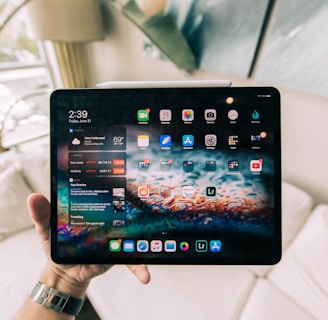BuSYMOMHAVEN
How to Manage Screen Time Without Losing Your Mind: A Busy Mom’s Guide
Let’s be honest—managing screen time for kids feels like an endless battle. One minute, they’re innocently watching an educational video. The next, they’re deep into a YouTube rabbit hole of toy unboxings and dance challenges. Before you know it, hours have passed, and they’re melting down when you tell them it’s time to turn it off. As a busy mom, you need screens sometimes—whether it’s to get through dinner prep, take a work call, or simply catch a break. But at the same time, you don’t want too much screen time turning your kids into overstimulated zombies. So, how do you find balance? How do you set boundaries without constant fights? In this guide, I’ll share practical tips to manage screen time without losing your mind, plus Amazon-recommended products to make the process easier.
PARENTING TIPS
2/17/20253 min read


Why Is Screen Time a Problem?
Before we dive into solutions, let’s talk about why excessive screen time is a concern:
🔹 Behavioral Issues: Too much screen time is linked to meltdowns, attention problems, and sleep disturbances in kids.
🔹 Disrupted Sleep: The blue light from screens reduces melatonin, making it harder for kids to sleep.
🔹 Reduced Physical Activity: More screen time means less outdoor play, exercise, and hands-on creativity.
🔹 Social & Emotional Challenges: Kids who rely too much on screens may struggle with real-world social skills.
But the truth is, screens aren’t inherently bad. The key is balance and boundaries.
Step 1: Set Clear, Age-Appropriate Screen Time Limits
Instead of battling “one more episode” arguments, set clear screen time rules ahead of time.
General Guidelines for Screen Time by Age (AAP Recommendations):
✔️ Ages 0-2: Minimal screen time, except for video chatting.
✔️ Ages 2-5: 1 hour per day of high-quality content.
✔️ Ages 6-12: No more than 2 hours per day of recreational screen time.
✔️ Teens: Encourage balanced use with school, social life, and physical activity.
💡 Amazon Product Recommendation: Echo Dot Kids Edition (Shop Here) – A screen-free alternative that allows kids to listen to stories, music, and audiobooks instead of watching screens.
Step 2: Use Parental Controls & Monitoring Tools
If you’re not monitoring your child’s screen use, they can easily access inappropriate content or waste hours scrolling.
Best Tools for Managing Screen Time:
✅ Amazon Fire Kids Tablet (See it Here) – Comes with built-in parental controls, educational apps, and time limits.
✅ Gryphon Guardian Mesh WiFi Router and Parental Control SystemCheck it Out) – A device that connects to your home WiFi and automatically manages screen time across all devices.
✅ Google Family Link – Lets you control app downloads, bedtime limits, and usage tracking.
💡 Pro Tip: Set up device-free zones (like during meals or bedtime) and use timers to enforce limits automatically.
Step 3: Replace Mindless Screen Time with Engaging Alternatives
One of the best ways to reduce screen time without tantrums is by offering fun, hands-on alternatives.
Screen-Free Activities Kids Actually Enjoy:
✔️ STEM & Building Kits – Keeps their hands busy with creativity.
✔️ Outdoor Play Gear – Encourages active fun instead of sitting indoors.
✔️ Audiobooks & Podcasts – A great way to keep kids entertained without a screen.
💡 Amazon Product Picks for Screen-Free Fun:
Osmo Genius Starter Kit (Shop Here) – A hands-on educational toy that blends digital learning with physical play.
Melissa & Doug Craft Kits (See It Here) – Engaging art kits that keep kids entertained.
National Geographic Rock Tumbler Kit (Check it Out) – Fun, science-based screen-free activity.
🚀 Mom Hack: Create a “Screen-Free Fun Bin” – A box filled with puzzles, art supplies, books, and building blocks. Whenever they ask for screens, give them the bin instead!
Step 4: Model Healthy Screen Time Habits
Let’s be honest—we struggle with screen time, too! If we’re glued to our phones, our kids will naturally follow.
How to Set a Good Example:
✔️ Limit your own screen time when with your kids.
✔️ Have “no-phone zones” (like family meals or bedtime).
✔️ Use screens for learning & connection, not just mindless scrolling.
💡 Amazon Product Pick for Parents: TimeFlip 2 Smart Time Tracker (See Here) – Helps busy moms track and reduce their own screen time.
Step 5: Make Screen Time Intentional, Not Mindless
Instead of letting screens take over, make screen time purposeful and enriching.
How to Encourage Mindful Screen Time:
✅ Use educational content. Choose apps that teach instead of just entertain.
✅ Co-watch shows or play games together. Engage in their screen time, so it’s interactive!
✅ Use screens as tools, not pacifiers. Instead of defaulting to a tablet, find other ways to calm a fussy child (like sensory toys).
💡 Amazon Pick for Better Screen Time: Amazon Fire TV Stick with Parental Controls (Check It Out) – Helps curate kid-friendly, educational content.
Step 6: Set Screen Time Rewards & Consequences
If your kids resist screen limits, tie screen time to positive behaviors and daily responsibilities.
Example Reward System:
✔️ Homework done? Earn 30 minutes of screen time.
✔️ Chores completed? Earn extra educational app time.
✔️ Tantrum-free day? Choose a movie night as a reward!
💡 Amazon Recommendation: Chore Chart for Kids (Shop Here) – A fun way to track screen-time rewards based on completed tasks.
🚫 What to Avoid:
❌ Bribing with screens (e.g., “Stop crying, and you can have the tablet”).
❌ Using screens as the only form of discipline (e.g., always taking them away).
Final Thoughts: Finding the Right Balance
Managing screen time doesn’t have to be a constant fight. By setting boundaries, providing alternatives, and using the right tools, you can create a healthy screen routine that benefits both you and your kids.
Key Takeaways:
✅ Set age-appropriate limits and stick to them.
✅ Use parental controls & monitoring tools.
✅ Offer engaging, screen-free alternatives.
✅ Be a good role model for screen time habits.
✅ Make screen time intentional, not mindless.
🌟 What’s your biggest challenge with screen time? I’d love to hear from you! 💬
Support
Empowering busy mothers with practical life solutions.
Connect
Inspire
momlife@busymomhaven.com
© 2024. All rights reserved.
